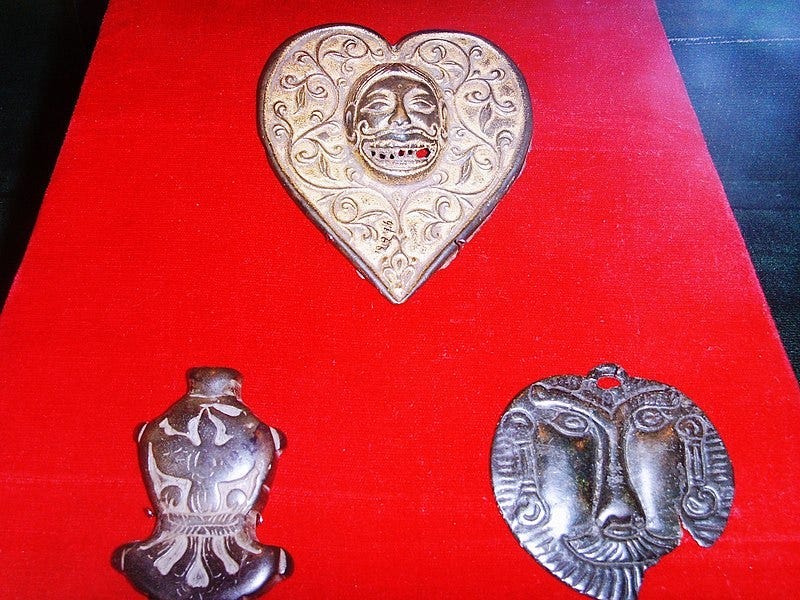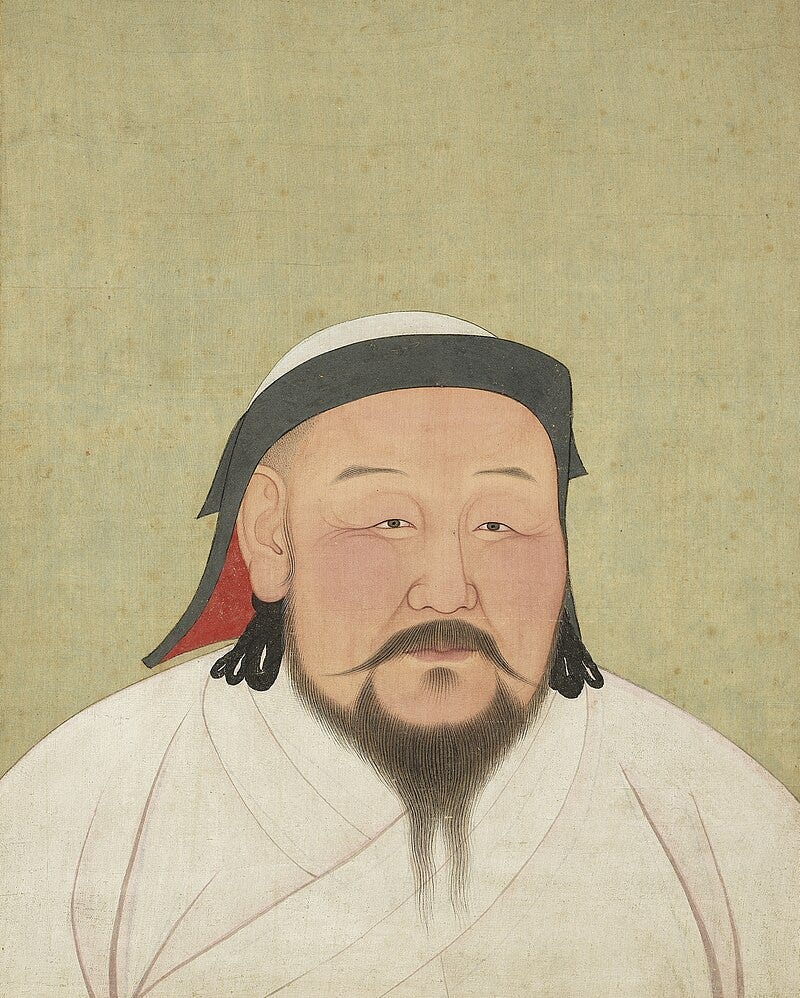Did Chinggis Khan Have Red Hair and Green Eyes?
A curious case of supremacist historiography with roots in wrong translations
Welcome to another edition of Forgotten Footprints.
It's been a while since I've done a historical myth-buster, and today, we’ll pick up a popular rumor that floats around social media from time to time: the appearance of Chinggis Khan, the great Mongol conqueror.
I’ve come across claims of Chinggis Khan being an Anglo-Saxon man who ruled the Mongol Empire because of his reported red hair and green eyes, such as the tweet below.
We can dismiss the poorly photoshopped picture as an internet hoax, and the description is quickly rubbished in the misinformation bin, but claims about Chinggis Khan’s alleged Caucasian-like appearance aren’t new.
Hence, they merit a closer look.
In 1899, Carlos C. Closson, author of a multi-volume work, The Races of Europe, likened Chinggis Khan’s features to that of a Norman. Why did Closson say so? Was there a hidden agenda, or did he come across historical sources discussing how the Great Khan looked?
We’ll review Closson’s comments and the shoddy research behind them. But first, let’s find out the origins of Chinggis Khan’s rumored red hair and green eyes.
Before we begin, I'd like to clarify why I use "Chinggis" instead of Genghis, as some of you have asked about the proper spelling of the Mongol conqueror's name. Most of you are familiar with "Genghis," pronounced "gayn-ghis" as the English rendition of the Great Khan's name. The Mongolian pronunciation of the name sounds like Chinggis Han, with a silent "k." However, Han has a different meaning in English and relates to the Han Chinese ethnic group. We'll use the term "Khan," also recorded in Persian and Arabic sources, to avoid confusion. But I'll stick with the Mongolian version of the first name.
I'll use Chinggis in this and all subsequent stories about Mongol history. I'll apply the same principle to other Mongolian names, spelling them as closely as possible to their original pronunciations. However, I'll mention the standard English spelling the first time introducing the character.
With that out of the way, let’s begin our search for the origins of the rumors about the Great Khan’s appearance.
Chinggis Khan’s Red Hair: Lost in Translation?

Before discussing the textual references to Chinggis’ appearance, keep in mind that red hair isn’t unusual among people of the Eurasian Steppes. Some Kyrgyz, Mongolians, and Kazakhs are born with natural red hair.
Chinese records from the 10th century mention the Yenisei Kyrgyz, a Turkic tribe living along the Yenisei River in Northern Mongolia and Siberia, as having red hair and green eyes.
But does this mean Chinggis Khan could’ve had red hair and green eyes? Is there any proof of his hair and eye color?
Those who promote the idea of Chinggis Khan as a Caucasian man with red hair and green eyes cite the 13th-century historian Rashid-al-din Hamdani, a vizier of the Ilkhante. After the death of Möngke Khan, Chinggis’ grandson and the fourth Mongol ruler, the empire was split into four parts: the Yuan Dynasty, the Golden Horde, the Ilkhanate, and the Chagatai Khanate.
The Ilkhante was the Mongol realm based in parts of present-day Iran, Iraq, Uzbekistan, Armenia, Azerbaijan, Georgia, Turkey, Afghanistan, and Pakistan.
Hamdani was born twenty years after Chinggis's death. He never met the conqueror. The Persian historian’s source of information was Bolod Chingsang, an official from Khubilai (Kublai) Khan’s court to the Ilkhanate. Khubilai, Chinggis’ grandson, was twelve when the Great Khan died.
Did Hamdani describe Chinggis Khan based on the memory of a twelve-year-old?
Not exactly. Let’s look at what Hamdani actually said about Chinggis.
When Khubilai was born, Chinggis met his newborn grandson and commented:
“all our children are of a ruddy complexion, but this child is swarthy like his maternal uncles. Tell Sorqoqtani Beki to give him to a good nurse to be reared.”

Hamdani discusses the complexions of Khubilai and Chinggis. Khubilai is said to have dark skin, similar to his mother Sorghaghtani’s family. The Persian historian uses the term siya-chardah to describe Khubilai’s complexion, which translates to black skin, meaning swarthy, not black as in color.
In contrast, Chinggis and his sons are described as ashgharani or “ruddy.” The original Persian word is closer to meaning reddish-white or reddish-pale.
Anyone exposed to chilly steppe winds will likely have a pale reddish complexion. The Eurasian Steppes are still home to “ruddy” looking people. The most important thing to remember about Hamdani’s commentary is that he was referring to the skin tones, not hair colors, of Chinggis and Kublai.
How did the red hair confusion arise?
Could a mysterious fruit help us trace the origins of the rumor about Chinggis’ hair?
Keep reading with a 7-day free trial
Subscribe to Forgotten Footprints to keep reading this post and get 7 days of free access to the full post archives.



